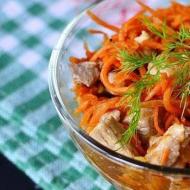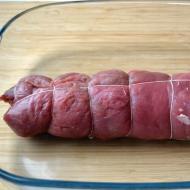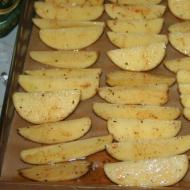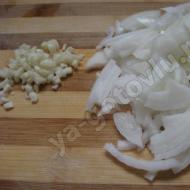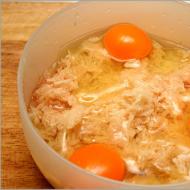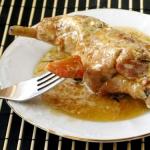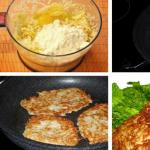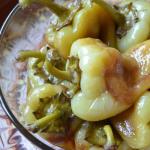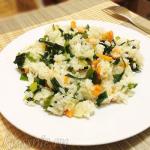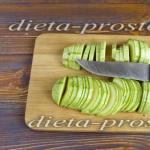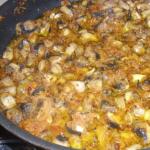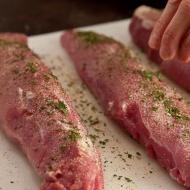
Crumbly pilaf without meat. Pilaf without meat cooking recipes with photos
Pilaf is probably the most famous rice dish. The first information about him can be found in the epic of the peoples of the East and numerous historical legends. The medicine of those times considered pilaf to be very healing and recommended it for all sorts of ailments, exhaustion of the body, from the effects of long starvation and for the rehabilitation of seriously ill patients. It was recommended to eat this dish both before and after performing heavy physical exertion.
History reference. Different peoples claim to be the first to invent a dish called “pilaf”. Name « palov osh » means from ancient Persian it is composed of the first letters of 7 components of pilaf:
- P (pioz) "bow"
- A (aez) "carrot"
- L (lahm) "meat"
- O (olio) "fat"
- In (wet) "salt"
- Oh (about) "water"
- Sh (shawls) "rice"
And he gave the name to the dish none other than - Ibn Sina (Avicenna). In his opinion, “palov osh” had healing and nourishing properties.
The Italians call pilaf - "risotto". The Italians adopted this dish from the Arabs and worked on it so much that it has dozens of options, with various combinations: with shrimp, mushrooms, meat, ham, vegetables, tomato sauce and cheese.
The Spaniards call plov - paella, it is probably also adopted from the Arab conquerors and is very popular not only in Spain itself, but throughout the world.In Iraq, a lentil version of plov is popular.
In addition, there is also pilaf in Bulgarian, Indonesian, Filipino and many others. And Muslims joke, saying that pilaf has as many recipes as there are Muslim cities in the world.
Pilaf recipes are different for different peoples of the planet. Changing at least one of its components leads to the emergence of new recipes - both tasty and undoubtedly healthy.
Pilaf is cooked according to the classic recipe in a cast-iron cauldron, but if there is no such vessel in the house, it is possible to use thick-walled ones - frying pans, ducklings, pots and stewpans - the result will be no worse.
The stages of cooking pilaf are also approximately the same - preparing the components of pilaf, heating the oil (or fat), cooking the frying called “zirvak” and, of course, the rice itself.
Oriental and Asian chefs who know a lot about cooking pilaf recommend adding various seasonings and spices, and their quantity is important. The calculation is simple - add one and a half to two teaspoons of a mixture of seasonings per pound of rice.
Recipe No. 1 Folding pilaf without meat (base)

This recipe is basic and very easy to prepare. Such pilaf is popular everywhere, as it is the basis for any recipe.
For cooking you need:
- 200 grams of rice;
- 400 ml of water;
- 20 grams of ghee;
- Salt half a teaspoon.
- Rice washed with cool water is poured into boiled salt water, and is not cooked until fully cooked for about 12-15 minutes.
- Next, the rice is thrown into a colander and washed with just water.
- When the water drains, oil is added to the rice and gently mixed.
- Pour a little water to the semi-finished buttered rice and cook until fully cooked on low heat. 15 minutes.
Recipe number 2 Vegetarian pilaf with beans without meat

Vegetarian cuisine - her recipes definitely include legumes. They prepare hearty and delicious meals. Pilaf of such a recipe can decorate the table for everyday and even festive.
For cooking you need:
- Long grain rice 500 grams;
- Red beans 300 grams;
- 2 carrots;
- 1 large onion;
- 1 head of garlic;
- Raisins 100 grams;
- Grow oils 50 grams;
- Salt to taste.
- Soak the beans overnight in cold water.
- Rice is well washed (several washes) with water and stands in water for half an hour.
- Vegetables - chop onions with carrots: onions in half rings, grate carrots.
- In a prepared container with oil, lay out in layers: beans and onions, carrots and raisins. We add a little layers.
- The last layer will be rice - we distribute it on top, and an unpeeled head of garlic is placed in the center.
- Fill the pilaf with boiling water, rice is covered with water for 2 fingers.
- Cooking time is 40 minutes on medium heat. We don't touch, we don't interfere.
- After the specified time, the layers are mixed, the vegetarian pilaf is ready without adding meat.
- Salads from different vegetables (favorite in your family) are prepared and served for pilaf.
Recipe №3 Pilaf without meat mushroom with vegetables

Russians have recently become more and more willing to join the observance of various Orthodox fasts. For some, this is a way of spiritual personal cleansing, but there are those who use this moment to lose weight. Beginners are faced with the fact that their menu is very monotonous. We offer a healthy pilaf recipe.
For cooking you need:
- 2 cups rice (any variety)
- 20 mushrooms (champignons or forest);
- 2 large eggplants;
- 2 bell peppers;
- 4 fresh tomatoes;
- 1 carrot;
- 3 tablespoons of butter;
- 3 tablespoons of vegetable oil;
- 1.5 glasses of water (replacing vegetable, meat broth);
- Dill, salt.
- The preparation of pilaf begins with frying chopped eggplant in medium cubes and medium-sized chopped tomatoes in oil.
- Pepper is cleaned from seeds and stalk, cut into narrow strips.
- Carrots are chopped into strips, stewed for about 5 minutes in butter.
- Onion chopped into half rings and mushrooms, chopped into thin plates, fry.
- We wash the rice in several waters and cook it until it is completely ready. Put the rice in a sieve to drain the liquid.
- We combine all the components in a container - vegetables and rice, add water (replacing the broth).
- We simmer the future pilaf on low heat until cooked. Salt and pepper 5 minutes before the end.
- When serving, sprinkle the finished pilaf without meat with dill.
Recipe №4 Pilaf without meat with tomatoes

This recipe will undoubtedly be noticed and appreciated by "vegans" and those who, for various reasons, do not eat meat and fish products. Try this wonderful recipe, it will definitely settle in your family's menu.
For cooking you need:
- Onion - 1 piece;
- Carrots - 3 pieces;
- Rice of any 400 grams;
- Tomatoes - 6 pieces;
- Eggs - 6 pieces;
- Vegetable oil - 2/3 cup;
- Zira - 2 tablespoons;
- Coriander - 1 tablespoon;
- Water - 1 liter;
- Salt, pepper - a pinch each.
- Soak the rice in water in the evening.
- Cut carrots into small strips.
- Remove the seeds from the tomato and add a little salt to each tomato.
- In a mortar, grind-mix 1 tablespoon each: salt, coriander and one teaspoon of cumin.
- The oil is hot. Fry onions, add carrots, add the resulting mixture of spices - pour water so that everything is covered with water. Extinguishing takes 10 minutes.
- Next, rice is poured on top, distributed evenly over the surface and water is added on top of the rice “on the finger”.
- Simmer over low heat until the water evaporates, then make small holes in the rice with a spoon, dimples and place the tomatoes in them. In the free interior, the tomato is broken into 1 egg.
- It remains to sprinkle the dish with spices and cook with the lid closed for 20-25 minutes.
- Mix the finished pilaf without adding meat and put it on a large plate-dish, and put miracle tomatoes next to it.
Rice
This is the main stumbling block of all cooks who have ever cooked pilaf. Nevertheless, almost all of them agree that devzira rice is the best, as well as other Uzbek and Tajik varieties.
You can try to cook pilaf with other types of rice, but preferably not too starchy. And in any case, the rice should be washed well before laying (until the water is clear). This will wash away the starch dust and prevent the pilaf from sticking together. Cooks also advise soaking it in cold water for an hour or more.
By the way, instead of pilaf, you can use wheat, chickpeas, corn and mung beans. But that's a slightly different story.
Meat
Lamb is traditionally used for pilaf, but beef is also suitable. You can also use pork, although Muslim cooks are unlikely to forgive you for this. A chicken option is also possible, but it already has little in common with the classic Uzbek pilaf.
It is better to choose the meat of adult animals: it gives the necessary rich taste.
The meat must be cut into fairly large pieces, about 5 × 5 cm or a little more. You can fry meat in large, non-portioned pieces and grind it just before serving. It is believed that the larger the piece, the juicier the finished meat will be.
Vegetables
There are two main vegetables in pilaf: onions and carrots. Onions can be used. It is more difficult with carrots: in Central Asia, pilaf is often cooked with yellow carrots, but in its absence, the usual orange one is also suitable.
The main rule is not to grind. Onions are cut into rings or half rings, carrots are cut into large sticks about 5 mm thick. If you finely chop vegetables and meat, you will no longer get pilaf, but rice porridge.
Oil
For the preparation of pilaf, either odorless vegetable oil, or animal fat (tail fat), or both types together are used. At home, the easiest way to use refined sunflower oil.
No need to skimp: pilaf is a fatty dish. On average, 1 kg of rice takes about 200–250 ml of oil.
Spices
There is a lot of room for experimentation here. And yet, more or less traditional seasonings can be distinguished:
- garlic (slightly peeled and laid with whole heads);
- hot red pepper (laid with a whole pod);
- zira;
- barberry;
- ground black or red pepper.
You can also add thyme, coriander, suneli hops, saffron or other spices to your taste in pilaf. The easiest way is to use a ready-made seasoning mix.
Other Ingredients
In addition to the components listed above, pre-soaked chickpeas and dried fruits are often added to pilaf.
What dishes to choose
A cauldron, a cauldron and another cauldron. With thick walls. In it, the meat does not stick, and the rice cooks evenly and remains crumbly. It is best to use a cast-iron cauldron (especially if you cook pilaf on a fire), but aluminum will do.
A duck can be a good substitute for a cauldron. But a saucepan, a deep frying pan, a wok and other kitchen utensils will not give the desired effect, no matter how much you want it.
The basic principle of pilaf is as follows: first, zirvak is prepared (meat and vegetables fried in oil with spices and broth), and then rice is poured on top.
The standard proportion for pilaf is equal parts of rice, meat and carrots. The number of onions may vary, but be at least 1-2 heads. The same with garlic.
Heat up the pot and pour the oil into it. It should warm up well so that later the ingredients can brown quickly.
Next, the onion or meat is fried. If you are cooking pilaf with a lot of onions, you can fry the meat first. Spread it into the cauldron gradually so as not to bring down the temperature, and do not turn over immediately - otherwise it may begin to release juice.
Onions need to be fried until golden brown so that the finished broth gives color to the rice.
Tveda.ru
When the meat and onions are fried, carrots are laid. It is fried for several minutes until softened.
 tveda.ru
tveda.ru Then all the ingredients are poured with hot water. It should cover the meat by 1-2 cm. Garlic, red pepper pod, spices and other ingredients are put next. Everything is salted to taste (or a little more salt is added than you like: the rice will absorb it) and cooked over moderate heat for at least 40 minutes until the meat is tender.
 tveda.ru
tveda.ru After the zirvak is cooked, rice is laid. It is better to do this with a slotted spoon to distribute the rice evenly. From above it can be flavored with a couple of pinches of cumin - for flavor.
- Rice is drowned in the broth (if necessary, more hot water is added through a slotted spoon so that it covers the dish a little) and stewed open until the water is completely absorbed (about 20 minutes). Then the fire is turned off (if the pilaf is cooked on a fire, then by this moment the firewood should simply smolder), the cauldron is covered with a lid and the rice is left to steam for about 15-20 minutes.
- After laying the rice, the cauldron is immediately closed with a lid and the contents are stewed for about half an hour at minimum heat, and then for about 10 minutes it comes without fire.
When the fire is turned off, wrap the lid with a towel: it will absorb the condensation and prevent it from getting into the dish.
Garlic and pepper are removed from the finished pilaf. If large pieces of meat were used for cooking, then they are also taken out, cut and spread on top of the mixed pilaf. If small pieces were used, you can mix the pilaf with them.
Pilaf is traditionally served on a large plate and topped with a head of garlic. This dish goes best with fresh vegetables.
 tveda.ru
tveda.ru Do you know other secrets of cooking pilaf? Share them in the comments.
Lean pilaf without meat is a simplified type of pilaf that you can make with ingredients that everyone has. Five ingredients, not counting spices, will help you create a fragrant and appetizing taste of pilaf. Even without using meat products, you can cook a very satisfying and appetizing dish that will be healthy and varied at the same time. In my recipe for pilaf without meat and bacon, I suggest you delve into the intricacies of Uzbek cuisine and cook a hearty meal for your family.
I want to say that the proposed recipe is very simple and unpretentious, which is more suitable for a family dinner than a festive dinner. But for guests, you can cook fragrant and rich pilaf without using meat. Use seasonings, berries, fruits and spices. In large quantities and a good combination, you can cook pilaf that will surprise any guest. So, you can use fresh quince, it is added to zirvak and fried in oil after frying a large amount of carrots, onions and garlic heads. Raisins or barberry - both of these seasonings will add aroma and taste. Cherries sprinkled with sugar, capsicum, prunes are also added for piquancy and a richer taste. From dry spices, use saffron, zira, turmeric, paprika, dried herbs.
Taste Info Second: cereals
Ingredients
- Rice 250 g;
- Sunflower oil 30 g;
- Bulb onion 215 g;
- Carrots 280 g;
- Garlic 1 head;
- Salt - 1 tsp;
- Ground black pepper - 1 pinch;
- Allspice;
- Bay leaf;
- Cumin seeds 1 tsp;
- Ground coriander 1 tsp

How to cook a simple lean pilaf without meat
Pour white long grain rice into a bowl. Rinse under running warm water 2-3 times until the water becomes clear. If you have devzira rice, you can use it, since it is from it that the dish of national Uzbek cuisine is prepared.

I use a tall cast iron skillet with a lid to cook pilaf. To cook pilaf, use a cauldron, ducklings or a deep frying pan with a thick bottom.
Let's make zirvak. Add vegetable oil to a frying pan, heat it slightly, pour in cumin seeds (zira) and ground coriander. Warm over medium heat for 1-2 minutes, until a subtle aroma of spices appears.

Prepare the onion, cut into half rings, cubes or quarters. Fry in a skillet with spices until golden brown, 4-5 minutes. For a more interesting color of pilaf, you can use the Crimean onion.

Wash and clean the carrots. Grate on a medium grater or cut into medium sticks. Add to the sautéed onion and continue frying for 10 minutes. During the frying process, you can add vegetable oil.
The longer the zirvak is fried, the tastier the pilaf will be, so do not rush.
At this stage, you can add barberry, raisins, cherries, zira, quince to zirvak.

Put clean rice on the sautéed vegetables. Spread it all over the pan.

Add spices: salt, allspice, ground black pepper, bay leaf and others to taste.

Put the peeled and washed head of garlic in the middle of the pan.

Pour the contents of the pan with boiled hot water, about 1-1.5 cm above the level of the rice, and cover with a lid. Put on a small fire and simmer without stirring for 25-35 minutes.

Pilaf without meat is ready, it turned out a delicious dish that will be especially relevant in fasting.

You can decorate it with herbs or other herbs. Serve immediately to the table. Enjoy your meal!
See what privilege they are waiting for you! And they will be available to you immediately after registration.
- Keep a personal blog and share your emotions
- Communicate, advise and receive advice on the forum
- Participate in super contests and win prizes
- Get advice and recommendations from experts and even the stars!
- Be the first to know about the juiciest articles and new trends
Lean pilaf is not at all rice porridge with carrots and onions, as most people used to think. Without meat, if you carefully study any recipe you like, you can cook a very tasty dish, which, moreover, will also be very useful. Such food wonderfully diversifies the diet of those who are on a diet and are rather tired of a monotonous diet. And this dish can easily be included in the children's menu, since it does not contain excessive amounts of animal fat.
Lenten pilaf is a godsend for dinner after a hot summer evening, when the body needs hearty and at the same time light food. It can be served for the holidays as a great side dish. And in order for the rice to turn out crumbly, you need to know some secrets and adhere to the correct cooking algorithm. If you want to learn how to make tasty and healthy pilaf without meat, then carefully study the recommendations described in this article, and you will definitely succeed.
Back to content
This recipe will really appeal to those of you who are used to saving time and at the same time want to eat delicious and healthy food. It will become indispensable for people involved in sports. This dish is a great option if you are fasting or are a supporter of the principles of a vegetarian diet. The pilaf recipe is very simple, and if done right, the taste of rice and vegetables will exceed all your expectations.
- medium-sized carrots - 3 pieces
- rice - 2 cups
- sunflower oil - 200 milliliters
- salt, spices - to taste
In the case of lean pilaf, special attention must be paid to the choice of rice. The fact is that if in the version with meat it is not the main ingredient, then the quality of the whole dish as a whole depends on its taste. You should not buy rice that is called steamed, because the heat treatment has already made it, so to speak, neutral. Better pay attention to cereals with white round grains. Of course, long rice is also suitable, but crumbly rice may not work.
So, here is the recipe for how to cook healthy vegetable pilaf. Rinse the rice thoroughly; the water drained from it should become transparent. Then soak it and set aside for an hour and a half. At this time, clean and wash the vegetables. Onion cut into half rings. Try not to make it too thin, because it is important that it is fried as little as possible during the cooking process. But carrots, on the contrary, need to be cut into sticks as thick as a matchstick so that it is extinguished faster. We can say that the secrets of proper chopping of vegetables, which the recipe for lean pilaf provides for, have already been revealed to you.
Now you need to choose the right dishes in which to cook this dish. If you have a cauldron or pan with thick walls, take it (her). In addition, the container must be spacious so that the water does not “run away”, but gradually turns into steam, thanks to which the rice is cooked. Pour vegetable oil into the cauldron, and when it warms up well, send the onion cut into half rings into it and cook over high heat. In this case, it is very important to prevent strong frying or burning. Therefore, constantly stir the onion until it becomes transparent and slightly golden.
Then send carrot straws to the cauldron and continue cooking until it becomes soft. You don’t need to fry, so don’t stop stirring your vegetable zirvak. When it is sufficiently stewed, you can drain the rice. Pour boiling water into the cauldron, for a given amount of ingredients you will need about 3 cups. Now salt and season the gravy. Make it taste full of spices, zirvak should be salty. Now put the rice in the cauldron and cover with a lid.
It's time to move on to the secrets of the temperature regime, thanks to which pilaf will never turn into porridge. So, the recipe provides for cooking for 12 minutes. First 3
of them - on high heat, then 7 more - on medium, and the final 2 minutes - on low heat. All this time, steam should not come out of the cauldron. Therefore, if the lid does not fit very tightly, put a towel on top.After 12 minutes, remove the pilaf from the stove, but do not open. He must, as they say, "reach" or "rest." But after 20 minutes you can admire the result of your labors. If desired, add finely chopped garlic to the dish or, when serving, sprinkle the plate with pilaf with herbs. If you did everything right and did not violate the cooking recipe, then rice will surprise you with its friability and excellent taste. And if it didn’t work out the first time, then what prevents you from improving your culinary skills and trying again?
Back to content
This recipe, judging by the number of ingredients indicated in it, is designed for a large company. It can be an excellent side dish and complement the festive menu. Such pilaf can be satisfying and tasty to feed unexpectedly arriving guests, because it is prepared quite quickly and simply, and every hostess usually has all the necessary components. By the way, the recipe for such a dish will also appeal to those who like to relax in the bosom of nature and at the same time eat deliciously without any extra effort and financial costs. And if you want to cook such pilaf for dinner for a small family, then just reduce the amount of ingredients. Just do it so as not to break the proportions.
- rice - 1 kilogram
- raisins - 150 grams
- large onion - 3 pieces
- carrots - 500 grams
- sunflower oil - 250 grams
- black zira - 2 teaspoons
- ground black pepper - 1 teaspoon
- salt - 2 teaspoons
Peel and wash vegetables. Chop carrots into strips no thicker than 3 millimeters, and onions into half rings. Take a cauldron, pour oil into it and put it on the fire to warm up. When the first smoke appears, send the onion to the dishes, which must be fried until a slightly brownish hue. Please note that the color of the pilaf will also depend on the quality of the onion frying. Then add the carrots and bring it to a soft state. In order for the vegetables in the cauldron to cook evenly, do not forget to stir them (at least 3-5 times during the entire roasting time).
When the zirvak is brought to the desired condition, add about 2 liters of cold water to it, add salt, ground black pepper and cumin. The taste of the gravy should be salty and rich. Pre-washed and drained raisins are also sent to the cauldron. Rinse the rice in warm water, draining it until it becomes transparent, and put it on top of the vegetables and raisins. This recipe does not provide for the soaking of cereals that has already become habitual. Level the layer of rice, and make the fire under the cauldron as high as possible so that all the water leaves the surface.
Now you need to do as Uzbek housewives usually do. Collect rice from the edges to the center with a slide and make holes in it with a knife, reaching to the very bottom of the cauldron. Let the remaining moisture boil off. Then cover the cauldron with a towel, and on top with a lid and make the fire minimal. This will prevent the steam from escaping quickly from the cauldron, so that the rice will cook properly. Typically, the process takes about half an hour. After this time, the pilaf must be mixed and put on a large dish. Serve it with a salad, and it is better to drink it with green tea. Enjoy your meal!
Housewives who have cooked pilaf with mushrooms at least once will say with confidence that they are an excellent substitute for meat. It is important to choose high-quality rice, do not spare seasonings and vegetables and withstand all the necessary proportions and cooking steps. Then the dish you served for dinner will be appreciated by your loved ones and will probably ask for more. Despite the fact that the recipe for lean pilaf with mushrooms is simple, the taste of this dish is rich and rich. And how to achieve this, read below.
- long grain rice - 900 grams
- large onion - 3 pieces
- large carrots - 3 pieces
- champignons - 800 grams
- sunflower oil - 300 milliliters
- garlic - 2 small heads
- a mixture of spices (paprika, coriander, hot red pepper) - to taste
- black zira
- salt - to taste
As usual, start with vegetables: wash and clean them. Remove all skins from the garlic. Chop carrots into thin strips, onions into half rings. Wash the mushrooms and cut them quite large, preferably in halves. If they are very large, then - in smaller pieces. Rinse the rice very thoroughly and then soak in cold water for 30 minutes.
Take a cauldron, heat vegetable oil in it and start cooking zirvak. To do this, fry the onion in it over medium heat until golden brown, then the carrots until soft. Add salt and spice mixture. After that, send the champignons to the cauldron and increase the fire. Saute the mushrooms for 3-4 minutes, stirring constantly. They should absorb the aroma of spices. Then pour 1.5 cups of boiling water into the cauldron, dip the garlic into it and leave the zirvak to cook on medium-low heat for about 20 minutes.
When this time is up, taste the gravy and add salt if necessary, taking into account that salt will no longer be added to the rice. Do not forget to remove the garlic from the zirvak, because it has already managed to give away all its flavor. Strain the rice groats and lay them in an even layer on top of the vegetables and mushrooms. Carefully, so that the ingredients do not mix ahead of time, add water. It should just barely cover the rice. Maximize the fire under the cauldron. Water, rising from below, will pass through all the layers of the future pilaf and cook it, so to speak, for a couple. If the rice is steamed unevenly, the recipe allows you to mix it with a spatula. But this must be done very carefully so as not to hook the zirvak.
When you notice that the cereal has become transparent, and the water has dropped to the level of vegetables and mushrooms, cover the cauldron with a lid. Before this, collect rice from the edges with a mound and stick garlic into it, sprinkle everything with cumin on top, and make the fire minimal. To prevent steam from escaping too quickly, cover the cauldron with a few towels as well. After 30 minutes, the pilaf is ready. Stir it and serve it to the table on a large beautiful dish.
Those who are at least a little familiar with vegetarian cuisine have often come across dishes that include legumes in the recipe. And this is quite natural, because thanks to their use it is possible to cook very satisfying and tasty food. Lean pilaf with beans is considered a traditional Indian food. It is very useful, unusual and looks very appetizing, so it will decorate any table, both festive and everyday. The recipe for this dish is so simple that even a person without much culinary talent can easily master it.
- rice long-grain varieties "Basmati" - 500 grams
- red beans - 350 grams
- carrots - 300 grams
- large onion - 1 head
- garlic - 1 head
- raisins - 100 grams
- sunflower oil - 50 grams
- salt - to taste
Soak beans overnight in cold water. This will allow her to cook faster later. Rinse the rice well and also leave it in cool water, however, only for 30 minutes. During this time, wash and peel the vegetables. As always, for pilaf, cut the onion into half rings, and for carrots, the recipe provides for a very unusual way of chopping. It must be grated, and even on a fine grater. This is necessary to give the pilaf a beautiful color.
Take a saucepan with a thick bottom, pour sunflower oil into it, then lay out strained beans, grated carrots, onion half rings and raisins in layers. Salt each layer. As you can see, the recipe does not prescribe any preliminary frying of the ingredients, there are practically no spices. Therefore, the dish can be called dietary, because there is also negligible vegetable oil in it.
When you have laid all the products in layers in a cauldron or pan, carefully spread rice on top of them, from which do not forget to drain the water first. Stick the garlic into it, disassembling the head into cloves, but without removing the skin. Now pour boiling water over the future pilaf so that the rice is covered by about 2 fingers. It is necessary to cook for 40 minutes over medium heat, without stirring.
After the specified time, connect the layers together with a wooden spatula and put the vegetarian pilaf with beans on a large dish. Serve with vegetable salad. As you can see, you can cook pilaf even without traditional zirvak. If you doubt that it will turn out to be successful, be sure to try this recipe, and as a result, you will be very surprised at how delicious this simple rice dish can be.
In our country, in recent years, the observance of Orthodox religious fasts is gaining more and more popularity. Someone really finds in this a way of spiritual purification, and someone, under such a plausible pretext, tries to get rid of excess weight and simply uses a significant deterrent. But in both the first and second cases, people are faced with the monotony of their menu. Agree, it is incredibly difficult to invent masterpieces from a very limited list of products. Almost every familiar recipe includes meat or fish.
Therefore, lean pilaf, which can be easily prepared by following the examples described above, will surely become the crown dish of your, for some period, poor diet. It was also appreciated by vegetarians, who, by virtue of their convictions, generally refuse meat and fish products. Therefore, you should not sigh sadly again, choking on boring oatmeal. It is better to choose the recipe you like and start cooking delicious, albeit lean, food.
Pilaf is not just a dish. This is a philosophy that every nation has its own. That is why, despite the commonality of the ingredients, the Uzbek pilaf differs from the Tajik one, and it can also be cooked in Azerbaijani, Bukhara, it can be with poultry, meat, and even with dried fruits. We will tell you how to cook pilaf according to all the rules, as well as adapt old national recipes for cooking in conditions and from products of traditional Russian cuisine.
You should start with this type of pilaf, as it can be considered a classic example, moreover, it is extremely common both in any cafes with an Uzbek bias, and in general in Russian kitchens.
So, Uzbek pilaf (it is also often called Ferghana pilaf) is prepared in such a way that the rice turns out to be friable, the rice does not stick to the rice. How to achieve this?
As the famous culinary specialist and connoisseur of national cuisine Stalik Khadzhiev assures, the volume of products is calculated based on the presence of rice.
Although an experienced culinary specialist usually does everything by eye, there is an exact recipe for Ferghana pilaf:
- 1 kg of rice;
- 350 g unsalted lard;
- 800 g of meat;
- 800 g carrots;
- 150 g onions.
Important! If you want to cook a real, even, say, authentic Ferghana pilaf, then look for yellow carrots, which you combine with an ordinary orange vegetable in a ratio of one to three. It roasts beautifully and looks good in the finished dish. If there is no yellow, then take the entire volume of ordinary carrots.
Such pilaf is prepared in a cauldron, but in the home kitchen you can take a thick-walled cast iron pan. A duck will do too.
Cooking:
- In a thick-walled cast-iron pan or cauldron over low heat, melt the lard.
- Heat it up well and put a couple of pieces of chopped meat. (It is cut into small pieces for Uzbek pilaf to fit in the mouth for one bite).
- After a minute, in hot oil, these pieces will be well fried, giving the fat the aroma of meat. Now they have to be taken out.
- Next, put the onion cut into half rings in the fat and fry over high heat to evaporate the water. After that, report the rest of the meat, salt and lay out a part of the carrots cut into cubes - first yellow. Salt it too and sprinkle with zira (zira is an obligatory ingredient in Uzbek pilaf).
- As soon as the carrots begin to fry, add the rest of it and mix everything. Let it fry a little. Then lay out the remaining vegetable, spices. In general, everything except rice, including those pieces of meat that were fried very first.
- Salt again, put a small pod of hot pepper, and add a teaspoon with the top of barberry, it will give the necessary sourness.
- Carefully pour hot boiled water along the edge of the cauldron or duckling, covering the meat and vegetables with it. Then, cover with a lid, leave for 40 minutes on the slowest fire.
- While zirvak is being prepared (this is the name of this rice dressing, it is the same for all cuisines where pilaf is cooked), we wash the rice. It is better to do this under running water to wash off the flour. If you don’t wash it off, you won’t get crumbly pilaf.
- Put clean rice in zirvak with a slotted spoon, salt at the rate of 1 tbsp. a spoon without a hill of salt per kilogram of rice.
- Put the washed whole head of garlic into the rice.
- Pour boiling water so that the water covers the rice on your finger.
- Bring to a boil, reduce the heat to a minimum, cover the pan with a lid and wait for the water to evaporate. When the rice is almost ready, turn off the heat, cover the pot or cauldron with a warm towel or blanket and leave to rise for another hour.
- Open the lid, put it on an Uzbek flat plate, put a salad of thinly sliced tomatoes with onions next to it and enjoy!
Loose pilaf in a cauldron
In principle, the previous recipe is also suitable for a cauldron. All components of the dish are taken in the same proportion, prepared in the same sequence. The only difference is that the almost finished pilaf is covered with a lid, and after that the fire under the cauldron is completely extinguished. But the cauldron remains lying on the bricks of the oven, the bricks give their heat to the rice layer, bringing it to the condition. The lid of the cauldron is covered with a blanket and therefore in itself is an additional source of heat. In this form, pilaf comes, and it turns out well stewed - just like if you were cooking it in a Russian oven.
in Azerbaijani
The difference between Azerbaijani pilaf and Uzbek pilaf is that the meat in it is cooked separately from rice, and a special flatbread called gazmakh is used to prepare the rice part.

Here is how plov is cooked in Azerbaijan:
- Pick up products - 700 g of lamb, 200 g of pumpkin, five onions, 100 g of ghee, half a pomegranate, half a glass of raisins, a little water, turmeric and salt to taste. You also need to take an egg and flour 220 g for a dough for a cake.
- Rice is deliberately not indicated in the dosage - it is cooked separately, so you can take it at your discretion. We wash it under running water or change the water several times. Put in salted boiling water and cook until almost done. After that, we recline, rinse with cold water.
- We make gasmah: add an egg and very cold water to the flour, knead a very stiff dough. We roll it into a thin cake.
- We spread the cake along the walls and bottom of the cauldron.
- Put half of the rice on the cake.
- The second part of the rice is tinted with yellow, mixed with turmeric diluted in a spoonful of ghee and a teaspoon of boiling water (take a pinch of turmeric).
- Pour melted butter over the first part of the rice, put yellow rice on top, cover the cauldron with a lid and steam a little more at a minimum of heat until cooked.
- Meanwhile, in a thick-walled saucepan or frying pan, fry the pieces of lamb in oil or your own fat. As it turns red, put finely chopped pumpkin and onion, pour in pomegranate juice, add raisins, mix everything with salt and, pouring half a glass of boiling water, keep for half an hour under a lid over low heat.
- When all parts of the pilaf are ready, put rice on a large round dish, meat and vegetables on top of it, decorate everything with pomegranate seeds and immediately lay the gazmah - break the cake with your hands.
If you are afraid of unconventional flavors, you can do without pumpkin.
Tajik pilaf with lamb
The main ingredients in this pilaf are traditional: rice, onions and carrots. But the meat is only lamb. In addition, Tajik pilaf is made from special rice - this red cereal is called devzira, it is the best and highest quality of all “pilaf” types. However, quite good Tajik pilaf can also be prepared from ordinary Krasnodar round-grain rice.
The peculiarity of the preparation lies in the fact that, first, onion (2 heads) chopped in half rings is overcooked in vegetable oil, achieving a strong frying, then meat (600 g) is added. It is also fried to a noticeable crust. After that, put the carrots in bars (600 g), overcook again and then pour in half a liter of boiling water. The meat should be half-cooked, after that rice (600g) soaked in salt water is laid and boiled water is poured so that the water covers the surface a little. Spices - zira and garlic. Under the lid, pilaf is cooked for another half hour.
How to cook pilaf - a basic recipe with pork
If there is no cauldron on an open fire, lamb and barberry, this does not mean that you will not get a delicious pilaf for dinner. The basic recipe that always turns out is pork pilaf. It is prepared quickly and simply, it requires 400 g of meat in pieces, a couple of large onions and carrots, 2 cups of rice and five waters. And also salt, bay leaf, a few cloves of garlic, a pinch of cumin and a few peas of allspice.

Vegetable oil should be taken so much that it is enough to fry the meat. After frying the pieces quickly, add the onion. Slightly reducing the fire, fry it and add the carrots. After frying a little carrot, pour in a glass of water and simmer for ten minutes under the lid. Put spices, salt. The broth should be a little salty - in the future, the rice will absorb the salt. Next is the washed rice. Pour it through a slotted spoon with water at the rate of 2 cups of rice twice as many cups of water. Bring to a boil, put the garlic cloves, reduce the heat to a minimum and leave to languish under the lid for 40 minutes. After that, turn off the fire and wait the same amount of time until the rice rests.
How to cook pilaf with chicken?
In the same way, you can use chicken instead of pork. You can cook chicken pilaf even faster, because it takes very little time to stew meat and vegetables. It is necessary to fry medium pieces of chicken in oil, salt. Separately, fry the finely chopped onion and a little garlic, add the grated carrots, still stew a little and add to the meat. Pour washed rice, parsley, peppercorns on top, salt well again and pour boiling water over. Cook over low heat for 20-25 minutes until the rice is soft. If necessary, you can add boiling water.
Recipe for multicooker
Pilaf in a multicooker is the signature dish of many, usually a multicooker even has a separate program for cooking pilaf, and therefore the time is predetermined by the microprocessor.

The recipe below is for 4 servings:
- Cut 250 g of any meat into small pieces, chop 1 carrot into bars, and the onion into a cube;
- Pour a couple of tables into an open multicooker. tablespoons of vegetable oil, set the frying program with a time of 25 minutes;
- The oil will warm up - put the meat in a piece. You do not need to put everything at once, otherwise it will not fry, but will be extinguished;
- After 10 minutes, add carrots and onions;
- When the frying is over, add salt, spices for pilaf, a couple of cloves of garlic, put washed rice on top;
- Pour about half a liter of boiling water (the water should cover the rice a little, one and a half to two cm);
- Put the program "Pilaf";
- When the task is completed, open the lid, stick in a couple of fresh garlic cloves, pierce the rice to the bottom with a wooden stick and leave for another twenty minutes to reach the pilaf in the heating program.
In a slow cooker, you can perfectly make a vegetarian pilaf without meat, as well as a sweet dish with dried fruits. Instead of meat, you need to put only vegetables or dried apricots with raisins, and reduce the frying time to 5 minutes.

